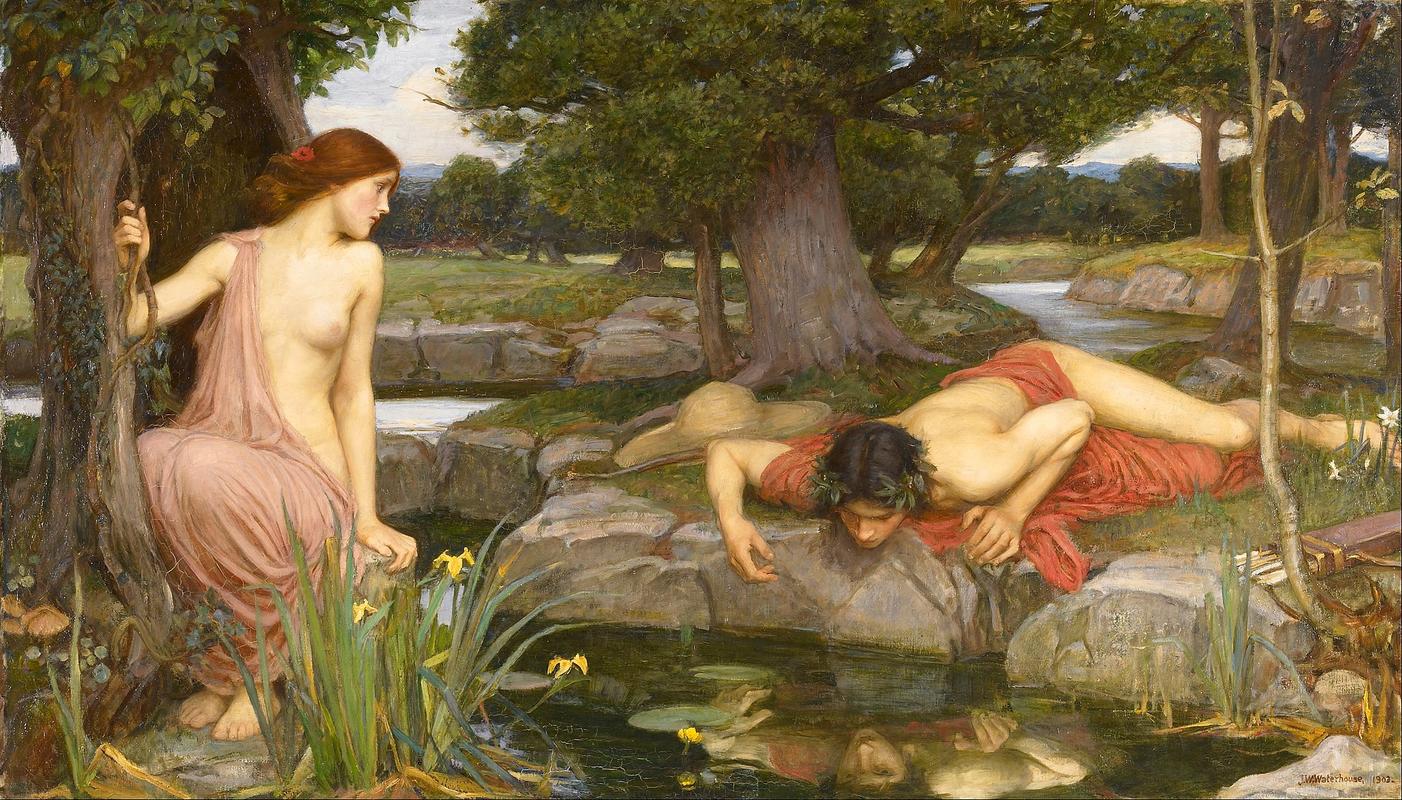More about Echo and Narcissus

Contributor
Narcissus, the first straight man who would rather stare at himself than see some boobies. *Queue “You’re So Vain” by Carly Simon*
Waterhouse’s 1903 painting depicts the Greek myth of Echo and Narcissus as told by the Roman poet, Ovid, in his epic poem Metamorphoses. The man depicted is Narcissus, son of the river god Cephissus and nymph Liriope, who was blessed with breathtaking beauty. He was so gorgeous that anyone who looked at him, woman or man, instantly fell in love. However, while Narcissus was beautiful on the outside, his soul was ugly and cruel. He callously rejected all those that professed their love for him without any remorse.
One such jilted lover was the mountain nymph, Echo, AKA the hottie with her boob out pictured above. This is the same nymph that in Book III of Metamorphoses was cursed by the queen of goddesses, Hera. Hera took away her voice and left her with only the ability to quietly repeat what others said. So needless to say that before Echo had her heart completely shattered by Narcissus, she was already pretty miserable. It’s funny how a f*ckboy always shows up when you’re most vulnerable.
Eventually, Nemesis, goddess of retribution and punishment, took pity on the multitude of poor, heartbroken souls tossed aside by Narcissus. She decided that the fitting punishment was to curse him to fall in love with his own reflection. Upon seeing his reflection in the river, he became unable to bear to look away and eventually wasted away. The legend goes that a single narcissus flower sprouted from the spot on the riverbank where he died.
John William Waterhouse used his classic style of soft, glowing colors and beautiful scenery painted in broad Impressionist inspired brush strokes to bring to life both popular and obscure mythological, literary, and historical figures. However, he had a certain fascination with tragic female figures. Waterhouse studied troubled damsels such as Ophelia, The Lady of Shalott, and even Cleopatra. But rather than painting the classic “damsel in distress,” despite their tragic circumstances, these women appear resolute and proud. Accordingly, instead of focusing on singularly on Narcissus in this painting, he chose to show the effect his decisions had on others by including Echo.
Sources
- http://www.liverpoolmuseums.org.uk/collections/lgbt/sex-and-eroticism/b…
- https://artsandculture.google.com/asset/echo-and-narcissus/cgGohYq-Vdec…
- https://www.britannica.com/biography/John-William-Waterhouse
- https://www.johnwilliamwaterhouse.net/biography.html
- https://www.tate.org.uk/art/artworks/waterhouse-the-lady-of-shalott-n01…
- https://theconversation.com/guide-to-the-classics-ovids-metamorphoses-a…
- https://www.britannica.com/topic/Echo-Greek-mythology
- https://greekgodsandgoddesses.net/goddesses/nemesis/
Featured Content
Here is what Wikipedia says about Echo and Narcissus (Waterhouse painting)
Echo and Narcissus is a 1903 oil painting by John William Waterhouse. It illustrates the myth of Echo and Narcissus from Ovid's Metamorphoses.
John William Waterhouse (1847–1917) was an English painter who, because of his style and themes, is generally classified as a Pre-Raphaelite. He painted over 200 works, mainly in the genres of classical mythology, and of historical or literary subjects. One of his common themes is the femme fatale, the woman who ensnares a man.
In Ovid's version of the myth, Narcissus was the beautiful son of the river god Cephissus and the nymph Liriope. His parents were told that he would live to an old age if he did not look at himself. He rejected all the nymphs and women who fell in love with him. One of these was the nymph Echo, who could only repeat the words of others. She was so upset by her rejection that she withdrew from life and wasted away until all that was left was a whisper. Her prayers were heard by the goddess Nemesis who caused Narcissus to fall in love with his own reflection in a pool of water. He continued to look at his reflection until he died. A narcissus flower grew on the spot where he died.
The painting is set in an idyllic wooded landscape beside a stream with rocky edges. The young Narcissus is lying prone, with his head over the water, fascinated by his own reflection. He is half-clad in a red robe, symbolising his flaming self-desire. The nymph Echo sits nearby across the stream, clasping a tree with her right hand, gazing at Narcissus in despair. She is symbolically separated from Narcissus, who does not look back towards her. Her cramped posture reflects her unrequited love. She is wearing a pink robe that has fallen off the left shoulder to reveal one breast; the milder pink of her robe reflects less passionate, smouldering love for Narcissus. Near her grow some yellow flag irises, Iris pseudacorus, and she wears a red poppy in her auburn hair. Some white narcissi have emerged from the grass beside the youth's foot, and a yellow water lily, Nuphar lutea, is in the water.
The painting is in oils on canvas and it measures 109.2 cm × 189.2 cm (43.0 in × 74.5 in). It was exhibited at the Royal Academy in 1903. It forms part of the Victorian collection in the Walker Art Gallery in Liverpool, Merseyside, England, having been purchased by the museum in 1903.
-
Study for Echo, c.1903
-
Study for Echo, c.1903
Check out the full Wikipedia article about Echo and Narcissus (Waterhouse painting)












